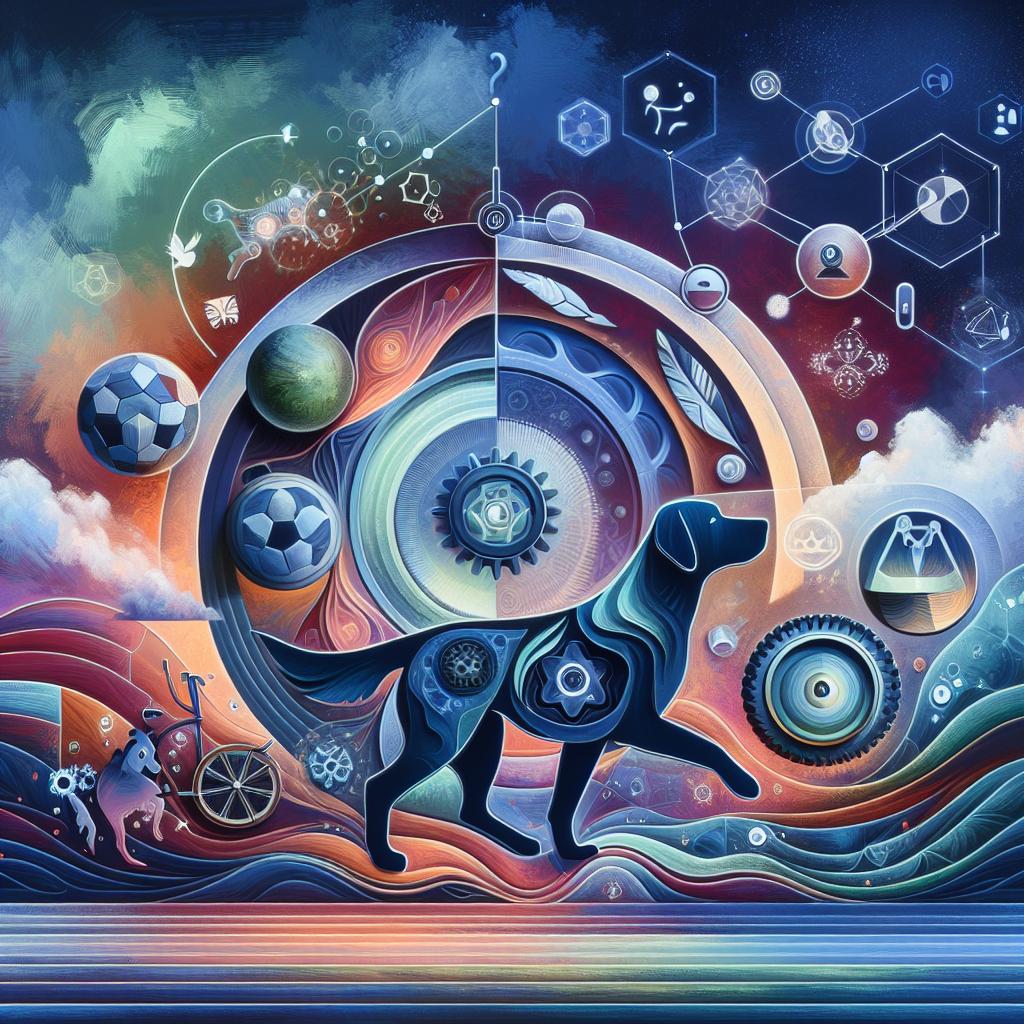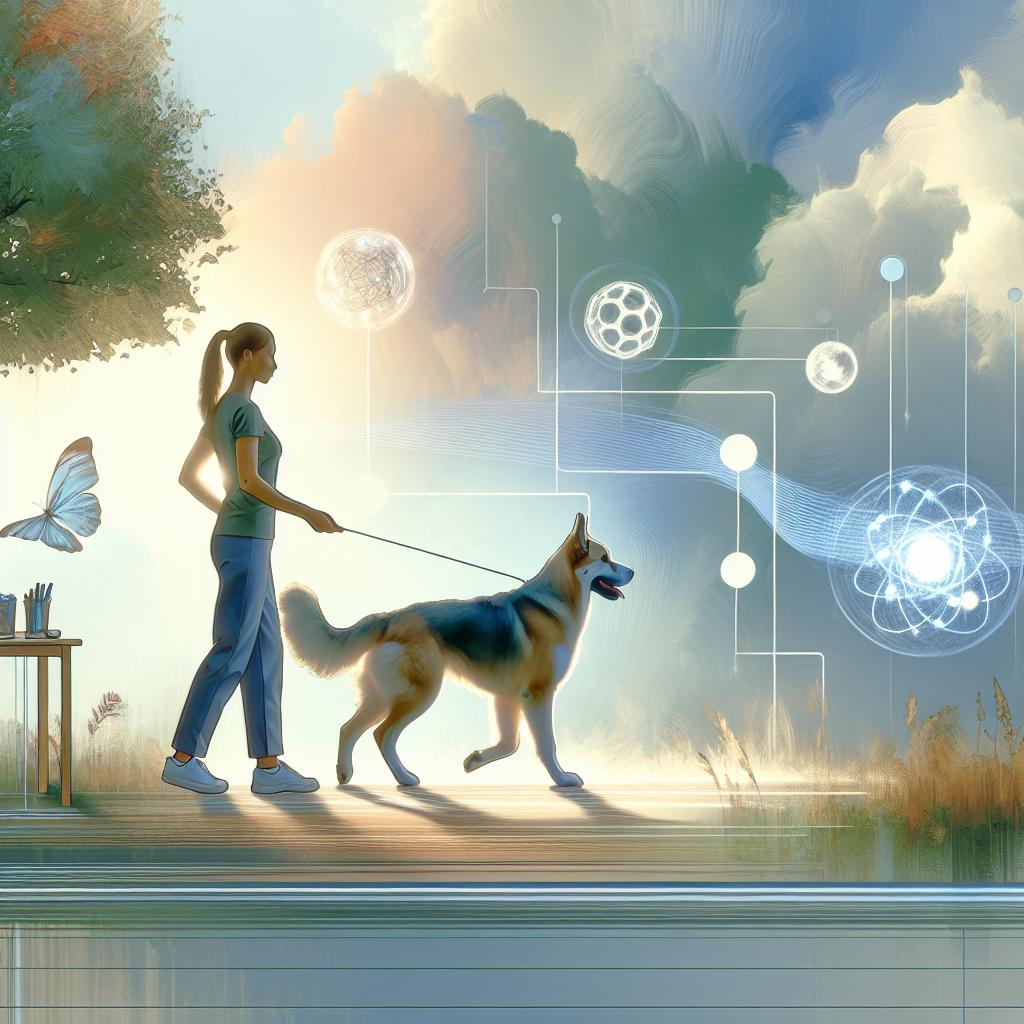Title: Addressing Hyperactivity in Dogs Through Training
Introduction:
In teh lively world of our four-legged companions, few traits can spark as much concern and curiosity as hyperactivity. For many dog owners, the sight of an exuberant pup bounding across the room or frantically chasing its tail can bring a mixture of joy and exasperation. Hyperactive dogs are often the embodiment of boundless energy, leaving their humans to wonder how to channel that enthusiasm into more productive behaviors. While some may perceive hyperactivity as merely a quirky personality trait,others recognize it as a challenge that can disrupt the harmony of home life. Fortunately, understanding the roots of this energetic behavior and implementing structured training techniques can transform an uncontrolled whirlwind into a well-mannered companion. In this article, we’ll explore the causes behind hyperactivity in dogs, effective training strategies, and the profound bond that can be forged through patience and perseverance.Join us as we embark on a journey to bring tranquility and balance to the spirited lives of our beloved pets.
Understanding the Roots of Hyperactivity in Dogs
To effectively address hyperactivity in dogs, it’s essential to first understand the underlying causes that contribute to this behavior. Various factors can play a critical role, including:
- Genetics: Certain breeds are predisposed to high energy levels.
- environmental Influences: A chaotic living space can heighten anxiety and restlessness.
- Lack of Physical Exercise: Insufficient activity can lead to pent-up energy manifesting as hyperactivity.
- Insufficient Mental Stimulation: Dogs require not just physical exercise but mental challenges as well.
Moreover, behavioral issues may arise from inconsistent training or a lack of structured routine. Understanding a dog’s individual temperament and needs is crucial. To illustrate this further, consider the following table that summarizes common causes of hyperactivity:
| Causes of Hyperactivity | Description |
|---|---|
| Genetic Predisposition | Some breeds are naturally higher in energy. |
| Environment | A noisy or unpredictable environment can contribute to anxiety. |
| Insufficient Exercise | Lack of physical activity can lead to excess energy. |
| Poor Training | Inconsistent commands can create confusion and stress. |

Effective Training Techniques to Channel Energy
To effectively manage hyperactivity in dogs, it’s essential to utilize a variety of training techniques that can help channel their energy in constructive ways. Engaging your dog through positive reinforcement is one of the most impactful methods. Reward your dog with treats, praise, or play whenever they exhibit calm behavior or follow commands. This not only boosts their motivation but also creates a strong bond between you and your pet. Consider using techniques such as:
- Structured Playtime: Incorporate agility training or fetch into your routine to give your dog a productive outlet for their energy.
- Regular Exercise: ensure daily walks and active play sessions to help reduce restlessness and maintain physical health.
- Socialization: Arrange playdates with other dogs to help them learn appropriate behaviors and expend energy in a safe environment.
another effective strategy is establishing a consistent training schedule that includes focused sessions on commands and tricks. This helps to stimulate their mind while reinforcing obedience. Consider introducing mental challenges such as puzzle toys or scent games, which require problem-solving and can tire them out considerably. To provide a clear overview of suitable training techniques, here’s a fast comparison of options:
| Technique | Benefits |
|---|---|
| Positive Reinforcement | Encourages desired behaviors using rewards. |
| structured Playtime | Redirects energy through interactive and physical activities. |
| Mental Stimulation | Increases engagement and reduces boredom. |

creating a Structured Routine for Calmness
Establishing a structured routine is crucial in fostering a sense of calmness for hyperactive dogs. by creating a predictable daily schedule, dogs can develop a sense of security and understanding of what to expect throughout the day. This routine can include specific times for feeding, walks, play, and rest, allowing them to channel their energy in a productive manner. Regularity in activities can definitely help minimize anxiety and overexcitement, leading to a more balanced demeanor.
To design an effective routine, consider incorporating the following elements:
- Consistent Feeding Times: Regular meal times help regulate their digestion and energy levels.
- Scheduled Exercise: Daily walks and play sessions, tailored to your dog’s energy level, are essential.
- Calm Down Sessions: Designate periods within the day for quiet time, utilizing crate training or a cozy corner for rest.
- Training Sessions: short, positive reinforcement training exercises can stimulate their mind and reinforce good behavior.
For a clearer view of a structured daily routine, consider the following table that outlines a sample day:
| Time | Activity |
|---|---|
| 7:00 AM | Feeding |
| 8:00 AM | Morning Walk |
| 10:00 AM | Playtime |
| 12:00 PM | Calm Down Session |
| 3:00 PM | Training |
| 5:00 PM | Evening Walk |
| 7:00 PM | Feeding |
| 9:00 PM | Quiet time |

The Role of Environment and Socialization in managing Hyperactivity
Understanding the impact of environment and socialization on managing hyperactivity in dogs is essential for effective training. A calm and structured environment can significantly reduce overstimulation, which tends to escalate hyperactive behavior. Key factors to consider include:
- Consistent Routine: Establishing a predictable daily schedule helps dogs feel secure and reduces anxiety.
- Safe Spaces: Designating quiet areas can give hyperactive dogs a retreat when they need to unwind.
- Minimizing Distractions: Keeping stimuli to a minimum, especially during training sessions, aids concentration.
Equally vital is the role of socialization, which fosters a well-rounded behavior in dogs. Proper interactions with other animals and humans can mitigate hyperactivity by encouraging calm and composed interactions. Consider implementing these strategies:
- Puppy Classes: Enrolling in training sessions allows dogs to learn social skills while expending energy positively.
- Structured Playdates: organizing controlled meet-ups with other dogs can help teach boundaries and imparts social etiquette.
- Positive Reinforcement: Rewarding desired behaviors during social encounters can enhance self-control and reduce hyperactive tendencies.
Q&A
Q&A: addressing Hyperactivity in Dogs Through Training
Q1: What are the common signs of hyperactivity in dogs?
A1: Hyperactive dogs frequently enough exhibit behaviors such as excessive barking, jumping, pacing, and inability to settle down. They may constantly seek attention or engage in destructive habits,like chewing furniture. If your dog seems unable to relax or find a calm spot during the day, it might be a sign of hyperactivity.
Q2: What causes hyperactivity in dogs?
A2: Hyperactivity can stem from a variety of factors, including genetics, lack of physical or mental stimulation, and insufficient training. some breeds, especially working or herding dogs, naturally possess high energy levels.Environmental factors, such as a chaotic home life or insufficient exercise, can also contribute significantly to hyperactive behavior.
Q3: How can training help reduce hyperactivity in dogs?
A3: Training addresses hyperactivity by providing structure and clear expectations. Positive reinforcement techniques, such as rewarding calm behavior with treats or praise, encourage dogs to develop better self-control. Consistent training routines also give dogs a sense of security and purpose, helping to channel their energy more effectively.
Q4: What specific training techniques are most effective for hyperactive dogs?
A4: Techniques include:
- Impulse Control Exercises: Teach commands like “stay” or “wait” to help your dog learn patience.
- Engagement Activities: Introduce interactive toys or puzzles that stimulate your dog’s mind and redirect excess energy.
- Focus Training: Use commands like “look at me” or “focus” to capture your dog’s attention and reduce distractions.
- Leash Training: Consistent walking on a loose leash promotes calmness and provides necessary exercise.
Q5: How much exercise do hyperactive dogs typically need?
A5: While every dog is different, hyperactive dogs generally require more exercise than their calmer counterparts. Aim for at least 30-60 minutes of vigorous activity each day,which may include walks,runs,agility training,or play sessions. Incorporating mental challenges, such as training sessions or puzzle toys, will also help tire them out.
Q6: Are there any signs that indicate a lack of training rather than hyperactivity?
A6: Yes, signs like disobedience to commands, frequent jumping on people, or a tendency to chase after everything can indicate a lack of training rather than true hyperactivity. If your dog responds well to commands when they’re calm but loses focus under excitement, it may benefit from more structured training rather than just an increase in exercise.
Q7: Can hyperactivity be a sign of underlying health issues?
A7: Indeed, hyperactivity can sometiems mask underlying health problems such as anxiety or hormonal imbalances. If your dog’s hyperactive behavior seems drastic or suddenly changes, it’s vital to consult a veterinarian for a thorough health check-up before pursuing training options.
Q8: How can I tell if my training methods are working?
A8: Look for gradual improvements in your dog’s behavior. Signs that your training is effective might include your dog being able to stay calm in situations that previously excited them, following commands more consistently, and engaging in calm play rather than chaotic outbursts. Progress may be slow,but patience and consistency are key!
Q9: Are there any additional resources or support tools for dog training?
A9: Yes,consider enrolling in obedience classes or seeking help from a certified dog trainer who specializes in hyperactivity. Books, online courses, and community resources like local dog training groups can also provide valuable guidance and support. Moreover, participating in dog sports can be both a fun outlet and a training opportunity!
Q10: any final advice for dog owners dealing with hyperactivity?
A10: Remember that addressing hyperactivity is a journey that requires patience and commitment. Celebrate small victories and maintain consistency in your training methods. With time and dedication, you’ll foster a calmer, more balanced relationship with your energetic companion!
Future Outlook
addressing hyperactivity in dogs is a journey that requires patience, consistency, and understanding. By utilizing positive reinforcement techniques and tailoring training to meet your dog’s individual needs, you can transform that boundless energy into a well-mannered companion. Remember, every dog is unique, and what works for one may not work for another. Embrace the process,celebrate the small victories,and most importantly,strengthen the bond you share with your furry friend. With dedication and love, you can definitely help your dog find a balance between playfulness and calm, paving the way for a harmonious life together.As you embark on this training adventure, may you both discover not just a new way of interacting, but a deeper connection that enriches your lives.Happy training!

